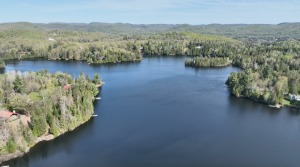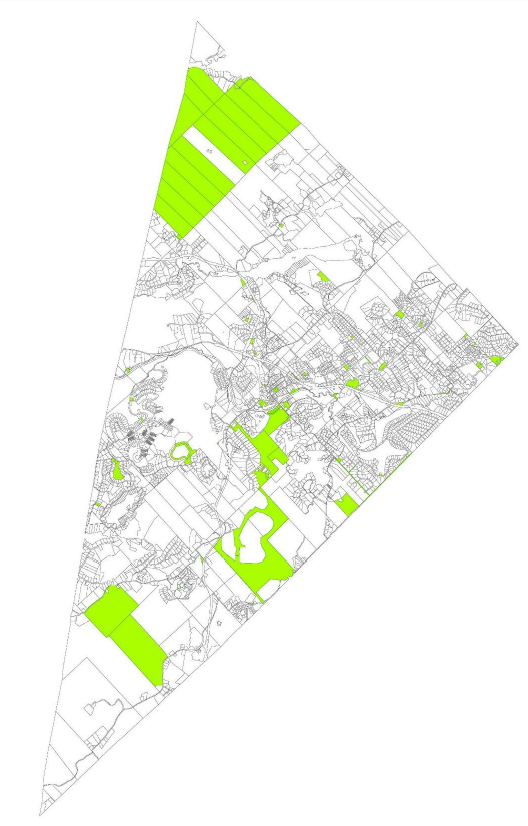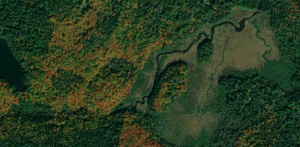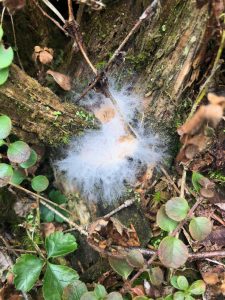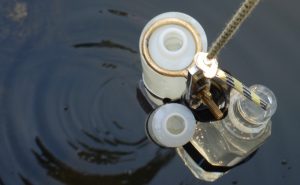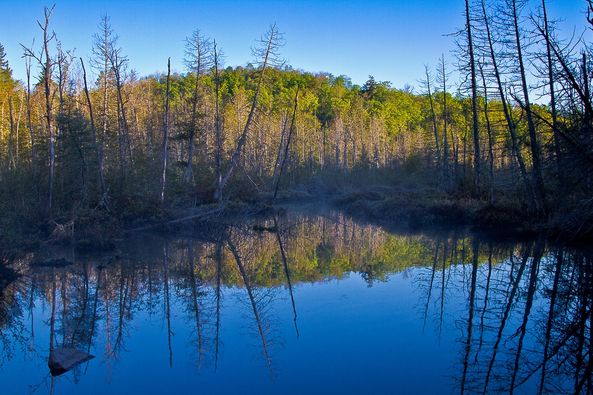Dr. Lena Measures, a research scientist with experience in water science, resident of Morin-Heights and long-time member of Ruisseau Jackson (RJANP) submitted a memoir to the municipality in the context of the call for input on the « Environmental and transitional Policy ». Public consultations on the policy were called by the municipal council and the Environmental Advisory Committee (EAC) members. The entire population was consulted to identify the priorities of this new environmental and transition policy.
Today, we are reproducing segments of her submission with permission. The memoir was produced in the spring of 2022 but we are reproducing excerpts from an updated version dated mid-July 2022.
Sections of the submission that were left out:
– Preamble
– Climate change and transition to environmental sustainability
– Recreation
– Quality of Life
Many recommendations from Dr. Measure’s memoir correspond to our vision of what a sustainable future could look like in the region but the views, thoughts and opinions expressed are those of the author and do not necessarily reflect the views of the association.
This municipal policy on which Ruisseau Jackson was consulted proposes an action plan in order to implement concrete measures and, as such, we believe in the sharing of information and ideas to make sure the development of an environmental policy is well informed. Some suggestions on actions and regulations for the new urbanism plan and relevant regulations are included in Dr. Measure’s memoir. Recommendations are not exhaustive and were copied from the original memoir, which provides much more context.
For Mathieu Régnier, President of Ruisseau Jackson (RJANP), “the environmental and transitional policy as well as associated municipal and collective interventions could allow Morin-Heights to remain a front runner in ‘real estate restraint’ an important issue for our association; one that should be at the heart of responsible land use planning – and of all actions geared towards climate change mitigation.”
The following ideas are certainly of interest for the local community and we hope you find the reading as interesting as we did.
“ (…)
Water
“Water is critical for all life forms. Aquatic environments (wetlands, lakes, rivers, streams) provide important ecological services and critical habitat for aquatic and semi-aquatic flora and fauna (beneficial microbes, plants, insects, amphibians, reptiles, fish, birds and mammals). Ecological services include: filtering and degrading some pollutants, providing potable water for humans and animals and restoring ground water reservoirs.
Development and uncontrolled human activities degrade these services leading to severe economic losses (flooding, property damage and loss of property value, eutrophication of lakes and rivers, contaminated ground water and wells, algal blooms, with negative effects on human and wildlife health). Toxic algal blooms kill wildlife, domestic animals and sicken humans and render lakes unavailable for swimming or other recreational activities. Contaminated water leads to boil water advisories (i.e., Balmoral area recently). As the ambient air temperature increases 1oC, the atmosphere holds 7% more water vapour which results in more intense precipitation events. Flooding in specific locations on the Morin Heights territory over the past several years has washed out roads and damaged properties.
As all water for human use comes from ground water, it is paramount to protect and conserve this resource. Studies to verify the capacity of ground water resources for new commercial or residential projects (costs to be borne by developers) should be conducted particularly in light of climate change with results posted on-line for residents and non-residents to access. It may be advisable to verify ground water resources municipality-wide every 5 to 10 years to avoid problems as seen elsewhere: https://ici.radio-canada.ca/nouvelle/1845435/approvisionnement-eau-potable-monteregie-mrc-jardins-napierville.
The town of Sutton was forced to stop a development project as there was insufficient water for the projected demand. Similar problems were reported in St. Lazare (CBC-TV Montreal report, June 22, 2022). Saint-Hippolyte is requiring developers of any residential project to conduct hydrogeological studies of water availability for projects involving 5 or more wells using the same aquifer and hydrogeological monitoring will be required for projects involving 10 or more wells using the same aquifer including submitting annual analysis reports (see https://saint-hippolyte.ca/saint-hippolyte-resserrera-le-developpement-residentiel-pour-proteger-ses-sources-deau-potable/ ). Morin Heights can learn from these examples.
• Frequent intense rainfall events and rapid snow melt due to a warming climate cause specific flooding events for which the municipality must develop emergency measures (larger culverts, vegetated water reservoirs for storm water capture which hold and slowly release water, etc.)
• Construction sites must cover material (disturbed soil piles, sawdust, construction waste) so that wind, rain and snow does not transport this material into ditches and water bodies.
• Trucks requiring water to keep down dust, for asphalting or road construction must not draw water from rivers or lakes – there is a risk of transferring invasive species from one body of water to another. Use a hydrant or water truck. (…)
• Preserve and protect wetlands, lakes, rivers and streams including intermittent streams by enforcing a wide buffer zone around said water bodies sufficiently large to minimize any effects from runoff or pollution or negative effects from construction including houses, roads, dynamiting, road sanding and salting. Exceed provincial minimum standards on protection of shorelines and water courses at high water levels in particular high-risk areas.
• Water quality in wetlands, rivers, lakes, and streams must be monitored prior to, during and after any surface disturbance for adverse nutrient loading, micro-organisms and chemical contaminants at the developer’s cost using independent evaluators recommended by the municipality and reporting to the municipality to avoid undue influence. If any contaminants are detected, all work must stop until the source is identified and mitigated.
• Adequate barriers must be installed to protect water bodies from any potential contaminants during construction activities including repair and maintenance of roads. (…) Not only must citizens respect the law but municipalities must respect the law – see Quebec Environmental Quality Act R.S.Q. chapter Q-2 Articles 19.1, 20 and MRC des Pays-d’en-Haut Regulation 259-2012.
• Areas prone to erosion such as steep slopes (>30%), mountain summits, and river banks require special protection by planting vegetation so roots hold the soil. No development must be allowed in proximity to these areas. These areas need to be identified and mapped. (See Ste-Adele website – map identifying zones at risk of soil movement).
• Protect ground water from depletion due to excessive demands for services such as aqueducts, wells, pools, lawn watering. This is particularly critical in light of climate change when droughts may diminish ground water resources. See above.
• Public education needs to be improved through the municipal website, InfoMorin Heights, Newsletter, seasonal pamphlets, etc. to inform citizens about eliminating use of phosphates and other chemicals that could pollute water bodies, planting native shoreline plants, washing watercraft and water toys before using in a different river or lake to avoid introduction of aquatic invasive species such as Eurasian water-milfoil or toxic algae (CRE Laurentides 2016).
(…)
Natural green spaces
Forests provide important ecological services but are disappearing due to uncontrolled development. Trees, their roots and soil absorb water, reduce runoff and erosion. Trees and soil are valuable carbon sinks mitigating climate change and reducing risk of drought, heat and fires. Trees break the wind and cool the environment in summer (reducing the heat-island effect). These are all ecological services that are worth millions of dollars.
Natural forests and artificial green spaces (public parks) are fragmented (Fig. 2) on the municipal territory forcing wildlife (deer, moose, wolves, etc.) to cross roads causing vehicle accidents with death of animals and injuries to humans including property damage. The SQ documented 48 deer accidents from 2014 – 2018 between the Simon River Bridge and the border with St-Sauveur (T. Watchorn, pers. comm.). According to the Nature Conservancy of Canada the average cost of a vehicle collision with a deer is $10,671, with a moose $49,398.
Fragmented forests act as biological islands with negative biological consequences for biodiversity and genetic integrity of flora and fauna. In the Morin Heights Environmental Policy Survey Results (2022) the highest rating (4.75/5) was given by respondents to `preserve forests and woodlands, limit deforestation, minimize heat islands”).
• Wildlife corridors connecting biological islands must be incorporated in any landscape planning and development.
• A detailed inventory of the territory in terms of biological assets (flora and fauna) must be conducted and the last remaining large undeveloped lots must be protected from development. Land reserves or trusts can be used to create protected natural areas. Use citizen science to help with this inventory, incorporate wildlife corridors where trails exist – increase width of buffer zones to at least 10 m.
• Create new trails and wildlife corridors where possible, working with adjoining municipalities. Consult and work with Eco-corridors Laurentiens for guidance on locating wildlife corridors. (https://ecocorridorslaurentiens.org). Use financial surpluses, funds and reserves to purchase the required land.
• Protect sensitive environments near wetlands and other water bodies where steep slopes may erode during extreme weather events. Plant trees to hold the soil where needed.
• Increase minimum lot size to 10,000 m2 or 107,639 ft2 for which the calculation of the minimum lot size must exclude any wetlands, aquatic environments, trails or unbuildable terrain such as cliffs, ravines, slopes>30%, etc.
• The footprint or surface area of residential houses should be limited to avoid the `McMansion` syndrome, houses that are more appropriate for Westmount or Outremont (Editor’s Note: also known as monsterhomes e.g. Blainville, Golf du Balmoral, Dix-30, etc.). A percentage of the minimum lot size should be established for the footprint encompassing a house, driveway, garage, well and septic system. If more space/rooms are required, build up, to a maximum of 9.2 m high, but the footprint should remain the same.
• Developers must work around existing trails and be denied permission to move them.
• Preserve valuable old growth trees which hold more carbon than young trees. However, young trees are also valuable as they absorb carbon at a faster rate than old growth trees.
• Limit deforestation, only a certain percentage of a lot as a function of lot size can be cut as proposed in Bylaw 638-2022, an excellent initiative.
• Deforestation is associated with rapidly proliferating roads. Restrict building or extending existing roads. Is it necessary to have wide roads which require extensive deforestation? Morin Heights is not a suburb of Montreal nor Laval nor is it desirable to become one. For example, at the Plateau project, the clearing for the road is so wide a small plane could be landed there.
• Preserve trees by burying hydro, fiber-optic and telephone utility services underground to reduce power outages during storms and to leave a wider margin of trees beside roads.
• An arborist or forester recommended by the municipality and who reports to the municipality must be hired by the developer to assess the tree cover, species, age and condition of trees on a lot and which ones can be cut to maintain ecological services.
• There should be no cutting of trees during bird nesting season (March to September).
• Trees can be cut around the perimeter of a building to a maximal of 6 m from the foundation, up to 3 m maximum around the perimeter of a septic system, 2 m from an accessory building, 5 m from a swimming pool and 3 m from a gallery.
• A park contribution (either cash or land) from a developer must be calculated based on the area of the lot or lots that are buildable or constructible, i.e., excluding any part of the lot or lots such as wetlands, water bodies, shorelines, protected zones, trails and steep slopes. And the park contribution tax (10%) must be based on the sale price of the buildable lot after subdivision of the land.
• Funds collected from park contributions or environmental tax should be used to purchase and protect in perpetuity natural undeveloped areas of ecological value such as wildlife habitat, sensitive areas and wildlife corridors.
• Projects involving 5+ houses must be presented by developers to the community for public comment before any permits are issued by the municipality. Positive suggestions can improve projects and increase social acceptability and may point out certain problems that the municipality can require mitigation.
• New development projects must not be considered for approval until all lots from the developer’s previous projects are sold or houses built. i.e., development projects in the Blue Hills area have either no houses, few lots with built houses or unsold lots. In current market conditions, house sales and prices are in decline, and inflationary pressures are affecting mortgage rates. These conditions should cool a very hot market in Canada including in the Laurentians.
• Submitted development projects should be evaluated using a grid and point system. See St-Sauveur Good Practices and Land Use Planning and grid 2021; Ste-Adele draft Regulations relative to implantation plan and architectural integration 1314-2021.
• Morin Heights needs to designate more protected areas. With less than half the area of Morin Heights, a 26% smaller population and almost double the human density per km2, Piedmont has protected 22% of its territory and is purchasing even more land for protection. Morin Heights has 13.5% of its territory protected (T. Watchorn, pers. comm.) but this includes public land (Parc des Bouleaux) owned by the province and is not a municipal protected area. Without Parc des Bouleaux Morin Heights has only protected 5.6% of its territory – which is pitiful.
• Money from municipal financial surpluses, funds and reserves (close to 3 million dollars (Morin Heights Newsletter, 2022) should be used to purchase natural areas, trail buffer zones and wildlife corridors for conservation purposes.
Biodiversity
Without becoming too technical diversity is an ecological term which measures the number of species and their relative abundance in a biological community. High diversity refers to many species or equal abundances (total number of individuals of a species), low diversity to few species or unequal abundances.
Diversity tends to be low in human-dominated landscapes. If one has a goal of increasing or preserving “biodiversity” it is necessary to know what species are present and their abundance compared to historical data. For example, knowing whether there are large herbivores like moose, elk and deer, small herbivores like rabbits, woodchucks, porcupines, omnivores like skunks and raccoons and predators such as wolves, coyotes, foxes, bears, fishers, otters, fish-eating birds, etc. in a biological community and their abundance is important in determining not only the number of species, and their relationship to one another but whether a community is healthy and stable.
Knowing whether these species are abundant in number individuals or rare requires detailed ecological studies. For example, deer are present on the territory of Morin Heights and seem to be abundant (based on sightings) while wolves and coyotes are rarely seen and likely present in low numbers. Prey animals are usually more abundant than predators. Controlling the human propensity to feed deer especially in winter helps reduce the deer population as survival during winter is a function of deep snow, cold temperatures, lack of food and the presence of predators. If many deer are killed on roads, does this mean there are too many deer or does it mean there are too many roads fragmenting deer habitat? Incidentally, more deer means more deer ticks which carry the bacterium responsible for Lyme disease. Keeping deer in natural unfragmented habitats away from human habitation reduces human contact with ticks. Public education on how to avoid ticks can also be useful (see https://www.etick.ca/). Recent studies show that deer can carry the SARS-CoV-2 virus that causes CoVID-19 (Mallapaty, 2022).
An inventory of the flora and fauna on the territory would provide baseline data on (bio)diversity, presence of common or rare species and identify species at risk. See Biofilia 2012 study conducted for Lac-des-Seize-Iles.
- Identify locations where rare or species at risk occur and protect that area from human disturbance including development (i.e., protect milkweed plants for Monarch butterfly conservation, rare orchids, winter deer yards).
- Citizen science can help identify species and locations using such applications as iNaturalist, eBird, Merlin, etc. Many residents post photos on Facebook, Instagram or the Morin Heights website – species lists and locations can be compiled, to create a database. Interested citizens can assist with this.
- Public education – inform residents not to destroy native plants such as milkweed or wildflowers such as orchids. Educate citizens to plant indigenous species, avoid exotic plants, some of which are invasive.
- Regulate washing of watercraft and water toys before moving between water bodies to avoid introduction of Eurasian water-milfoil or toxic algae. See https://www.crelaurentides.org• Regulate against planting noxious and invasive species such as Giant Hogweed, Fragmites, purple loosestrife, ragweed, poison ivy or moving insect-infested firewood from locations outside the region. A list of noxious or invasive plants should be posted on the municipal website. Goldenrod (important for monarch butterflies) and even dandelions (important for early spring pollinators) are neither noxious nor invasive. Educate citizens on how to identify noxious or invasive species and provide advice on how to eliminate them.
- Protect trees during construction (wrap tree trunks with 2x4s and rope to prevent damage from heavy equipment. Avoid compacting soil around the roots of trees or exposing roots with heavy equipment or girdling trees by backfilling around the base of trees. See negative effects on some trees at the Allen Falls development. Damaged trees can take years to slowly die posing a risk to infrastructure when they fall.
- Leave dead trees standing as they are important nest sites for many bird species and must only be cut down if they pose a threat from falling on houses, hydro lines or other infrastructure. An arborist or forester can evaluate the safety of dead trees.
- Any landscaping by developers must avoid introducing non-native or invasive exotic flora.
- Identify natural wildlife corridors and preserve them, working with other municipalities. Corridors must be contiguous with natural forests and fragmented protected areas if at all possible. For example, a potential corridor could extend from Wentworth-North public lands through the Viking Club land, Sommet St. Sauveur land (Editor’s Note: or Ruisseau Jackson Natural Protected Area and Ruisseau Jackson Nature Reserve) to Parc des Bouleaux public lands to St-Adolphe-d’Howard.
Pollution of water and air
Clean water is essential to life as discussed above. Clean air (oxygen) is also essential for most life forms. Green plants uptake oxygen at night releasing carbon dioxide (respiration), and convert light energy and water into sugar compounds releasing oxygen during the day (photosynthesis). Polluted water and polluted air are probably the easiest problems to resolve at the community level through regulation and enforcement.
- Contaminants in the air, water and soil can be eliminated through regulation and enforcement. For greenhouse gases (GHG) see above suggestions under Climate Change. Dust from traffic, road maintenance, snow removal and residential or commercial construction can be minimized by better road design and use of non-toxic materials or traps to hold and retain this material which can then be removed later. Plan appropriately for water runoff on road surfaces where water pools, freezes and thaws in depressions degrading the surface and necessitating continuous repair (corner of chemin Lac Echo and chemin du Village) or water not draining towards the shoulder culverts (Blue Hills Road). Dust on work sites from heavy vehicle traffic, dynamiting and excavating can be kept down by spraying water and using geotextile barriers to prevent potentially contaminated water from running into ditches, wetlands and streams.
- Sand spread on roads in winter contains salt and some of this sand is recovered in the spring. This sand should be recycled if not already done so. The city of Calgary has a recycling program, recycling approximately 250 tonnes annually since 2019, avoiding landfill, saving money and the environment.
- Pollen from plants such as ragweed is a serious problem for some people. Pollen is, however, what most plants release to reproduce. Removing ragweed where possible is a solution, but it is often confused with goldenrod. Any control programs for ragweed, which causes allergic rhinitis or hay fever, must be cognizant of this confusion and not remove goldenrod, which is an important high-energy food for butterflies such as the Monarch, a species at risk. Antihistamines are effective in treating the symptoms of hay fever.
- Old septic systems can be a source of pollutants and bacterial contamination of the environment and must be inspected thoroughly at the owner`s expense and upgraded as required by provincial regulations.
- All pesticides, herbicides and inorganic fertilizers must be banned and the ban enforced. Public education can suggest alternatives.
- Noise, a form of pollution, from leaf blowers, chainsaws and automatic generators may need regulation. Banning leaf blowers (what is wrong with using a rake?) or restricting their use to certain days or hours may be options. Use of more quiet electric leaf blowers/mulchers which vacuum leaves and shred them so that they decompose more quickly and can be spread in gardens or around trees is an alternative. Educate the public that fallen leaves in the forest are not pollution but provide important nutrients for trees as they decompose. Wood ash (without any contaminants) contains calcium which can be distributed around the base of trees in order to restore calcium depleted due to acid rain.
- Alarm systems can produce considerable noise but are not usually of long duration.
- Educate the public that portable generators must only be used if power is out for more than a few hours except for emergency medical situations. In Morin Heights power frequently is off for seconds to minutes before returning. The unnecessary use of powerful noisy GHG emitting generators should be discouraged. Generators only need to be run for a few hours each 24-hour period to keep freezers and refrigerators cold, electronic devices charged, and hot water tanks hot. In the most recent major power outage, some generators were run for days non-stop. This is not only unnecessary and inefficient but very polluting (GHG emissions) and noisy for neighbours. Enclosing generators with ventilation may mitigate noise. Ban snowmobiles and quads from trails and gas-powered motorboats on lakes.
- Ban manicured lawns outside of the peri-urban area – they are often destroyed by moles or require herbicides to control weeds and endemic invaders. Alternative ground covers such as clover or creeping thyme, sweet woodruff, phlox, bunchberry are options.
- Noxious odours from motorcycles, traffic, BBQs, chainsaws, generators, fires, rotting garbage or compost are temporary in nature, but instances of abuse can be regulated with enforcement.
- Light pollution on the territory is a significant point of friction between neighbours. Large spotlights directed on properties disturb neighbours, affect wildlife and is a form of visual pollution particularly on mountain summits or slopes. They also waste energy. Residential outdoor lighting must be restricted to short-duration LED motion detectors rather than large spot lights that are sometimes left on all night. Lights should be directed downwards and fully shielded to prevent light from radiating throughout the environment. Lights should be in the red rather than the blue end of the light spectrum. “Warm white” bulbs with a colour temperature between 2,200 and 3,000K are more pleasing to human eyes.
- Citizens must be reminded to turn off outdoor lights and minimize any lighting during spring and fall bird migration. Birds are confused by bright lights and mortality of birds during migration is very high especially in cities with tall buildings. Consequently, houses on mountain summits with bright lights are particularly problematic during migrations. Notices on the Morin Heights website over the past two years have educated the public about this problem.
- Municipal lights including ski hill lights must have deflectors or be shielded to direct light towards the ground and be equipped with LED lights of low voltage (3000 K or less) that do not disturb wildlife (i.e., not blue light). Once lifts close at night all lights should be turned off. This saves energy and money for operators.
- The Chartes des Paysages Naturels et Bâtis des Laurentides (2004), to which Morin Heights is a signatory, aims to protect the Laurentian landscape by recognizing its natural, cultural and collective heritage. The diversity and large natural spaces of the Laurentian region are the `economic motor` but the landscape is becoming banal and threatened by `blind development`. The Charte advocates for the recognition, protection and appreciation of the Laurentian landscape with the implementation of its conservation falling to municipalities and citizens. `McMansion` houses on mountain summits that can be seen for kilometres, with bright lights, and the natural tree barrier removed so as to have a panoramic view, do not respect the vision of the Charte. They are not only a form of visual pollution to the eye but are driving Morin Heights visually towards the built landscapes of Ste-Adele and Mont Tremblant. This is not desirable. Enforcement of regulations on no cutting of trees on properties with panoramic views is required. Currently, there is blatant disregard for this existing regulation. A municipal inspector, arborist or forester needs to mark trees NO CUT before clearing or construction starts regardless of the location. Illegal cutting should result in fines and replanting of all cut trees of the same species at the perpetrator’s expense.
- Properties with junkyards and piles of waste are a form of visual pollution and possibly a source of contaminants. Regulations to require the clean-up and using enforcement, perhaps fencing, are necessary. (…) Property owners must maintain the cleanliness of their properties and this must be enforced with warnings, and or fines.
- Household and commercial waste collection whether garbage, recycling, or organic seems well organized and successful. It would be informative to know what percentage of recyclables are actually recycled or go to landfill. Buried communal depots in various locations may be useful particularly for cottagers. Public education could be improved by informing citizens not to overload their bins, especially garbage bins, as raccoons, attracted to garbage smells, remove bags leaving waste on the ground including plastic bags which are then blown into water bodies and the surrounding forest.
(…)
Final Advice
- The municipality needs to provide: better communication, better transparency, better information for citizens, better education, and better enforcement of regulations. Regulation without enforcement is useless and a waste of paper (i.e., trees).(…)• Hire a qualified environmental enforcement officer.
- Remember an urban plan is not a business plan.
- Morin Heights must not become a suburb of Montreal or Laval (Editor’s Note: or Blainville).
- Suggested operative words in the months to come: vision, clear objectives, identify risks, real action, protect, regulate and enforce.
Work with nature not against her and use nature-based solutions such as planting trees to reduce erosion, absorb runoff and store carbon. According to the Nature Conservancy of Canada nature is a valuable ally in solving major challenges such as flood mitigation, human health, food security, water quality, biodiversity loss, climate change, and more. As the pandemic has shown natural areas in Morin Heights, including dog parks, are highly valued by residents and non-residents and contribute to maintaining human mental and physical health and facilitate citizen interactions.”


